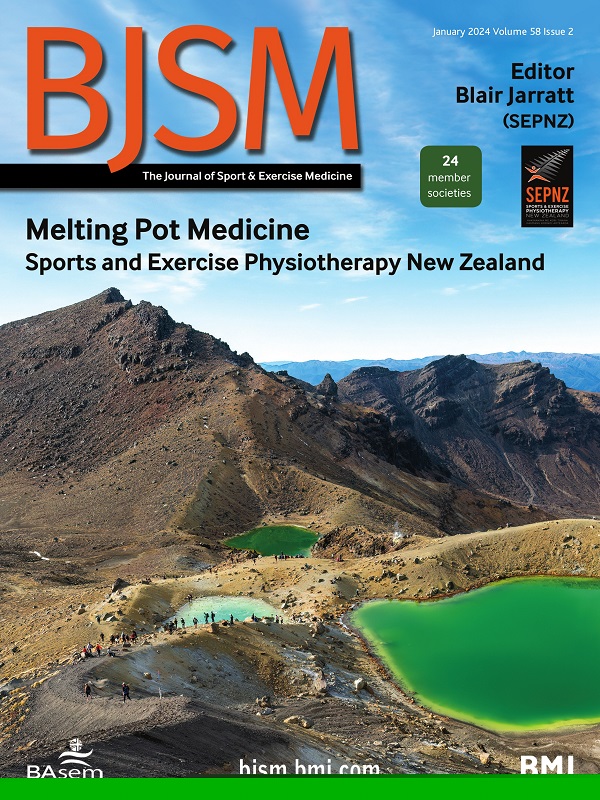Concurrent symptom domains and associations with recovery timelines among collegiate athletes with sport-related concussion
IF 11.6
1区 医学
Q1 SPORT SCIENCES
引用次数: 0
Abstract
Objective Concussion symptoms can be clustered into domains and understanding how multiple symptom domains present clinically may guide more accurate interventions. We investigate the associations between concurrent symptom domains and clinical recovery outcomes, as well as the role of sex in these relationships. Methods We analysed data from the Ivy League–Big Ten Epidemiology of Concussion Study and included sport-related concussions (SRC) across five academic years 2015–2016/2019–2020 with complete data (n=1160). We used symptoms from the Sport Concussion Assessment Tool 22-symptom evaluation, previously categorised into symptom domains. Symptom profiles characterise how athletes endorse concurrent symptom domains. Outcomes are time (in days) from SRC to symptom resolution, return to academics, and full play. Results Females more commonly endorsed headache, sensory, and affective symptom domains. Four classes/symptom profiles emerged: (1) ‘low’ on all domains, (2) ‘high’ on headache and sensory domains, (3) ‘high’ on vestibulo-ocular, cognitive, and sleep domains, and (4) ‘high’ on all domains. Time to symptom resolution, return to academics, and return to play were consistently shorter among class/symptom profile 1 compared with other classes/profiles. Compared with class/profile 1, the chance of having symptoms resolve was lower among classes/profiles 2, 3, and 4 (HR 0.74, 95% CI 0.63 to 0.88; HR 0.74, 95% CI 0.60 to 0.92; HR 0.50, 95% CI 0.43 to 0.57, respectively). Results were similar for return to academics and full play outcomes. Interactions with sex were not statistically significant. Conclusions Four symptom profiles characterised how concussion symptom domains co-occur. We found differences in recovery timelines among these groups, but not by sex. Findings inform and support targeted, symptom domain-specific interventions in concussion management. No data are available. Data are not publicly available due to current data sharing policies of the Ivy League-Big Ten Epidemiology of Concussion Study.运动相关脑震荡大学生运动员的并发症状域及其与恢复时间的关系
目的脑震荡症状可以聚类成多个域,了解多个症状域在临床上的表现可以指导更准确的干预措施。我们调查了并发症状域和临床恢复结果之间的关联,以及性别在这些关系中的作用。方法我们分析了常春藤联盟-十大脑震荡流行病学研究的数据,包括2015-2016/2019-2020五个学年的完整数据(n=1160)的运动相关脑震荡(SRC)。我们使用了来自运动脑震荡评估工具22症状评估的症状,这些症状之前被分类为症状域。症状概况表征运动员如何认可并发症状域。结果是从SRC到症状缓解的时间(以天为单位),恢复学业和充分发挥。结果女性更普遍认可头痛、感觉和情感症状域。出现了四个类别/症状概况:(1)所有领域为“低”,(2)头痛和感觉领域为“高”,(3)前庭-眼、认知和睡眠领域为“高”,(4)所有领域为“高”。与其他类别/症状特征1相比,类别/症状特征1中症状缓解、重返学校和重返游戏的时间持续较短。与类别/特征1相比,类别/特征2、3和4中症状缓解的机会较低(HR 0.74, 95% CI 0.63至0.88;HR 0.74, 95% CI 0.60 ~ 0.92;HR 0.50, 95% CI 0.43 ~ 0.57)。回归学术和充分发挥的结果相似。与性别的相互作用在统计上不显著。结论四种症状特征描述了脑震荡症状域的共同发生。我们发现这些组在恢复时间上存在差异,但没有性别差异。研究结果为脑震荡管理中针对性的、症状领域特异性的干预提供了信息和支持。无数据。由于目前常春藤联盟-十大脑震荡流行病学研究的数据共享政策,数据不公开。
本文章由计算机程序翻译,如有差异,请以英文原文为准。
求助全文
约1分钟内获得全文
求助全文
来源期刊
CiteScore
27.10
自引率
4.90%
发文量
217
审稿时长
3-8 weeks
期刊介绍:
The British Journal of Sports Medicine (BJSM) is a dynamic platform that presents groundbreaking research, thought-provoking reviews, and meaningful discussions on sport and exercise medicine. Our focus encompasses various clinically-relevant aspects such as physiotherapy, physical therapy, and rehabilitation. With an aim to foster innovation, education, and knowledge translation, we strive to bridge the gap between research and practical implementation in the field. Our multi-media approach, including web, print, video, and audio resources, along with our active presence on social media, connects a global community of healthcare professionals dedicated to treating active individuals.

 求助内容:
求助内容: 应助结果提醒方式:
应助结果提醒方式:


